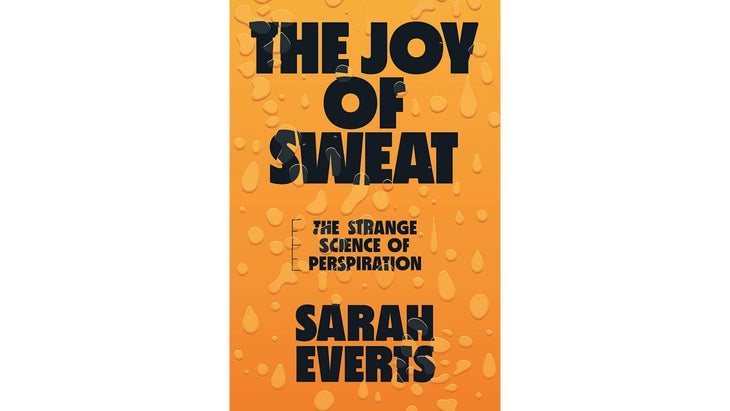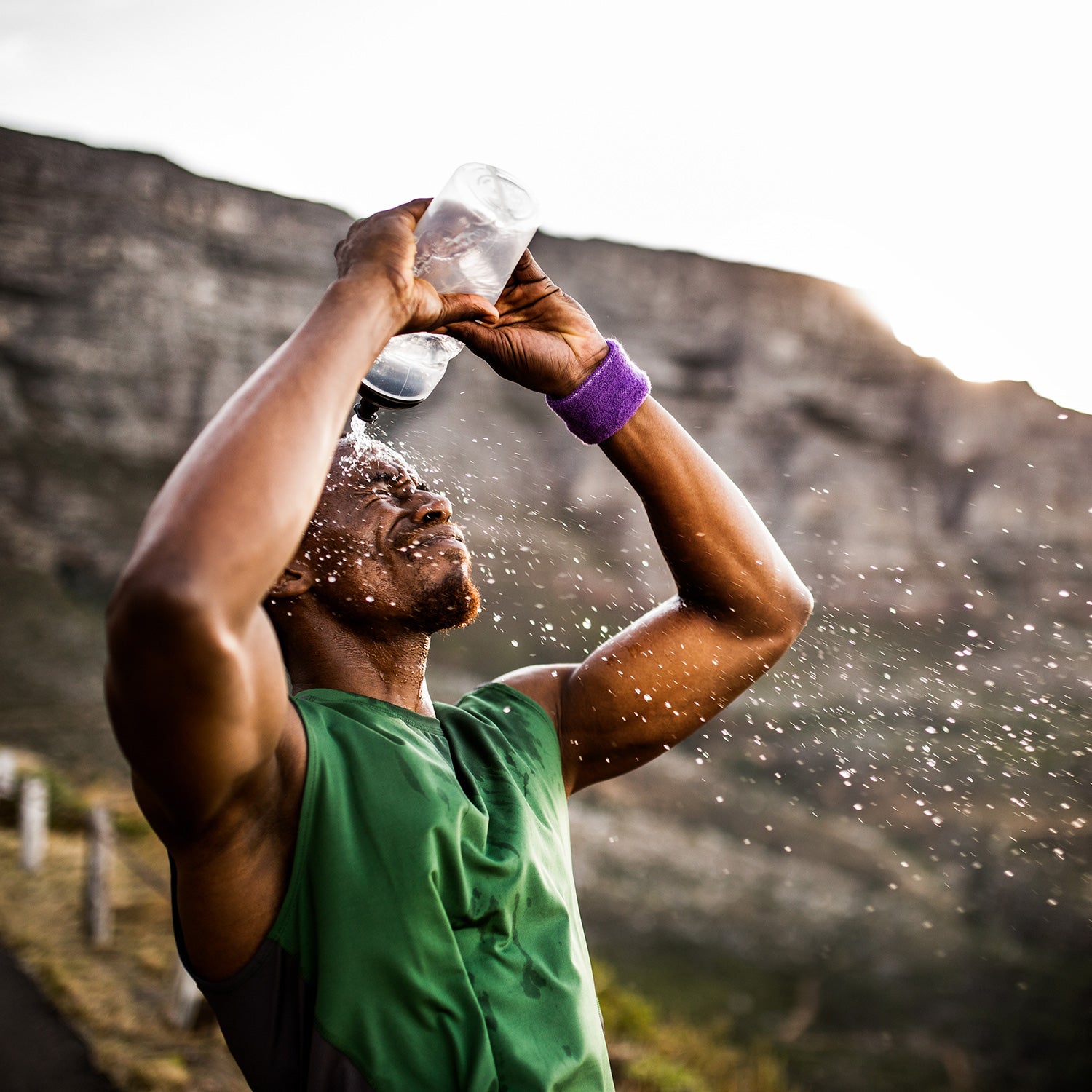I am a sweater. I don’t mean a tepid schvitzer or a gentle glistener. I mean that when I’m in a gym, on a treadmill, running at a decent clip, I am shedding buckets. I coat the machine in a corrosive, salty slather; my perspiration pools beneath me. Woe betide anyone working out next to me, sharing my dank microclimate. Once, in New Delhi during monsoon season, while out for a quick walk, my pants soaked through—to the mild amusement and concern of suspiciously dry passersby.
So I was particularly excited by a new book, , by Canadian science journalist Sarah Everts. Here was the chance to deeply understand this particularly human cooling mechanism (compared to other animals, we are champion sweaters), to grapple with my own moistness—to pore over my pores—and to answer a nagging question: Was it good for me to sweat so much, or somehow bad?
“Everyone is always sweating,” Everts writes in the book, which comes out this month. And we’ve been sweating for a long time, particularly since our evolutionary split from our fellow primates: we lost fur and gained sweat glands (we’ve got ten times as many as chimps). Compared to the myriad ways animals have to cool down—dogs pant, elephants flap their big ears, vultures poop on their legs and feet—we got a pretty fair shake.
“A dog pants to cool down by evaporating heat from its wet tongue,” Everts tells me. “That tongue is the only hairless surface that dog has on offer.” But we, the naked apes, “have our whole bodies available to us for that evaporation.” That was like hitting the “temperature-control jackpot,” according to Everts. “Being able to sweat means we could cool down while on the move. It’s why we can run marathons.” Where other animals would have to stop, to avoid heatstroke, we could keep going, stalking prey during the heat of the day. Born to run, yes, but also born to sweat.

But why do some of us seem to sweat differently? Body size matters, Everts says—the bigger you are, the more surface you have. And, surprisingly, gender plays a very small role. “Women have more sweat glands per unit area,” Everts says, “and men tend to have a higher maximum sweating rate.” These differences, she writes, can often be “attributed to other factors such as body size, aerobic capacity, or exercise intensity.” Where you were born probably plays some part, one that scientists . “Maybe the climate you grew up in trained your glands for a cooler climate of minimal sweating,” Everts says, “so that when you do get the heat on, they just go berserk.”
So while my sweating, thanks to biology and geography, might not be as efficient as it could be, I was relieved to hear that it doesn’t mean my fitness is subpar. “In fact, I think it means quite the opposite,” Everts says. Many athletes, she notes, report sweating “quickly and very voluminously” right when their workouts begin. “That’s because their bodies have learned that when the human who’s in control of that body starts to exercise, they are likely going to go very hardcore and to do so for quite some time. So your body is probably thinking, Oh gosh, there he goes again, let’s get cracking on the cooling.”
What might make someone like me particularly anxious about the sweat accumulating at the bottom of the treadmill, Everts says, is that unlike other body processes, “sweat is totally and utterly out of our control.” With other body processes, like burps, farts, pee, poop, even breathing, we have some ability to modulate, she says. But we can’t stop sweat. Once we start, there’s no holding it back.
And sweat, of course, is not always simply visible. In the book, Everts meets a sensory analyst, part of whose job description is to “bunny-sniff” armpits, or axillae, in the quest to build a better odor suppressant. There are two types of sweat glands: eccrine, or “the salty stuff that keeps your body temperature in check,” and apocrine, found in those places where you grow hair at puberty, which are often triggered by stress or emotional response. Apocrine glands pump out a kind of “waxy sweat, and it’s that sweat that’s responsible for turning armpits into stink zones,” says Everts. (Interestingly, sweat itself doesn’t have much odor—unless, notes Everts, “you’ve gone hard on the alcohol or the garlic.” But the sweat that accumulates in places like armpits, it turns out, is particularly appetizing for bacteria that live in the armpits. What you’re smelling is essentially bacterial poop.)
Everyone’s got their own signature scent; the Stasi, the secret police of what was formerly East Germany, used to collect sweat samples to help keep track of potential dissidents. There’s a general range of odors we give off, categorized via a sensory wheel not unlike that used in wine or cheese, with scent notes ranging from wet dog to grapefruit.
Sweat is a sort of channel for human communication, an “honest signal,” writes Everts, with all sorts of “chemical cues” lurking in our perspiration. The smell of sweat can tip us off to the presence of sickness in others, even before they begin showing symptoms. We also seem more likely to bond with people who smell like us (in one of the book’s stranger moments, Everts travels to Moscow to smell strangers’ armpits at a dating event).
Before writing The Joy of Sweat, Everts assumed the fluid was “just a banal mix of salt and water.” And so did I. But The Joy of Sweat, in the tradition of winning popular science books, entertains as it educates and makes a persuasive case for this everyday, overlooked element of our biology (what one researcher dubbed “skin urine”). What beads on the skin is a virtual distillation of what’s inside us. “Pretty much anything swishing around in your blood,” Everts notes, “is going to percolate out in your sweat.” She cites a German scientist who found that it took a mere 15 minutes for a drink he was imbibing (a curious Teutonic elixir that’s half Coca-Cola, half beer) to pass through his body and hit his pores. This doesn’t mean sweat is a detox mechanism, as it’s often purported to be; to truly detox, she notes, to flush the system of whatever impurities are lurking, you’d have to sweat out all 12 pints of blood. “You’d dehydrate and shrivel up and die,” she says.
And what about replenishing all that stuff that does come out, that ring of white salt I sometimes see on my cycling jersey on a hot day? Can sports drinks save us? Everts says the numbers don’t add up. To drink back into our body what we’re losing would be like drinking, in essence, a cup of pure sweat. “The amount of salt you’d need to consume would be unpalatable in liquid form.” Hence the dollops of sugar added to sports drinks. She counsels not to sweat the salt loss during exercise—you’ll get it back during your craving for salty snacks later on. Just enjoy the marvel of evaporative cooling that is human sweat, and be thankful that, like seals, we don’t have to pee on ourselves to lower our body temperature.


